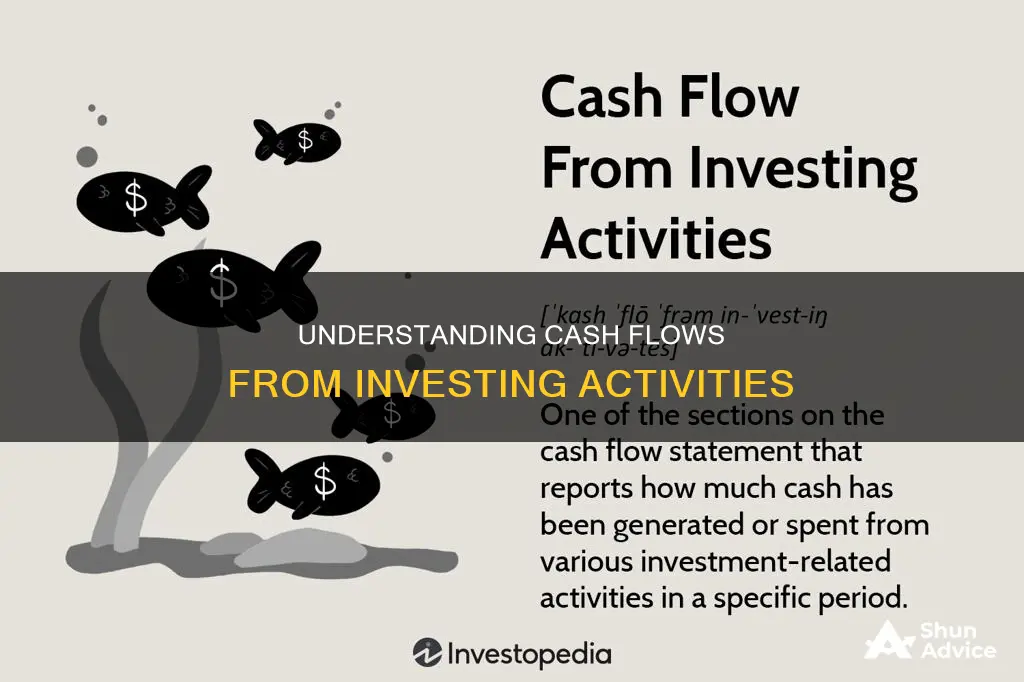
Cash flow from investing activities is a crucial component of a company's financial health and strategy, offering insights into its performance, capital allocation decisions, and long-term growth initiatives. This section of the cash flow statement details the cash inflows and outflows from various investment-related activities, such as the acquisition or disposal of long-term assets, investments in securities, and mergers or acquisitions. Positive cash flow indicates effective management of investments, while negative cash flow may signal expansion efforts or investments in future growth. Understanding these cash flow patterns is essential for stakeholders, investors, and financial professionals to assess a company's financial standing and future prospects.
| Characteristics | Values |
|---|---|
| Definition | Cash Flow from Investing Activities (CFI) is a section of a company's cash flow statement that reports the cash inflows and outflows resulting from investment activities. |
| Purpose | CFI tracks the cash inflow and outflow from investing activities, giving the net amount of cash generated or lost in a specific period. |
| Types of Activities | Investing activities include purchasing and selling investments, earnings from investments, and acquiring and disposing of assets. |
| Nature of Assets | Non-current assets (long-term assets) such as property, plant, and equipment (PP&E) are expected to deliver value in the long run but are illiquid. Marketable securities (stocks, bonds, shares) are more liquid and can be converted to cash more easily. |
| Calculation | Cash flow from investing activities = CapEx/purchase of non-current assets + marketable securities + business acquisitions – divestitures (sale of investments). |
| Negative Cash Flow | Negative cash flow from investing activities is not always a bad sign. It can indicate that a company is investing in the long-term health of the business. |
| Positive Cash Flow | A positive net cash flow indicates effective management of investments, with potential acquisitions or strategic investments to enhance future growth and profitability. |
| Importance | CFI provides insights into a company's capital expenditure and investment strategies, helping stakeholders assess the company's ability to invest in growth opportunities and manage long-term financial health. |
What You'll Learn

Cash Flow from Investing Activities: What It Includes
Cash Flow from Investing Activities (CFI) is a section of a company's cash flow statement that details the cash inflows and outflows from investment activities over a specific period. It is one of the three sections of a cash flow statement, the others being Cash Flow from Operating Activities and Cash Flow from Financing Activities.
Cash Flow from Investing Activities includes transactions related to the acquisition and disposal of long-term assets, such as property, plant, and equipment. It also includes investments in marketable securities, stocks, and bonds, as well as the acquisition and sale of other businesses.
- Purchase of fixed assets, also known as capital expenditures (CapEx)
- Purchase of investments, such as stocks or securities
- Sale of fixed assets
- Sale of investment securities
- Acquisition of another company
- Proceeds from the sale of other business units
- Loans made to third parties
- Collection of loans made by the entity
Cash Flow from Investing Activities does not include short-term investments, cash equivalents, or cash flows from financing activities. It also excludes the following:
- Cash received from sales of goods and services
- Payments made to vendors and suppliers
- Tax-related payments
- Payment of dividends
- Expenses related to asset depreciation
- Debt and equity financing
- Income and expenses related to normal business operations
Calculating Cash Flow from Investing Activities
To calculate Cash Flow from Investing Activities, you sum up all the cash inflows and outflows related to investing activities. Inflows typically include proceeds from asset sales, while outflows include purchases of investments. The formula is as follows:
Cash Flow from Investing Activities = CapEx/purchase of non-current assets + marketable securities + business acquisitions – divestitures (sale of investments)
Cash Investments: Impacting Stockholders Equity Positively
You may want to see also

How to Calculate Cash Flow from Investing Activities
Cash flow from investing activities (CFI) is a section of a company's cash flow statement that shows the net cash inflow or outflow from its investment activities over a specific period. It is an important indicator of a company's long-term financial health and growth prospects.
To calculate cash flow from investing activities, you need to consider the following:
- Purchases or sales of physical assets, including property, plant, and equipment (PP&E). These are often referred to as capital expenditures (CapEx).
- Acquisitions or sales of other businesses.
- Purchases or sales of marketable securities, such as stocks, bonds, or other investments.
The formula for calculating CFI is as follows:
CFI = Purchase/Sale of Property and Equipment + Purchase/Sale of Other Businesses + Purchase/Sale of Marketable Securities
Suppose a company has the following investing activities over a specific period:
- Purchase of property and equipment: $50,000
- Sale of other businesses: $75,000
- Purchase of marketable securities: $25,000
- Sale of marketable securities: $15,000
To calculate the CFI, you would add up all these amounts:
CFI = $50,000 + $75,000 + $25,000 + $15,000 = $165,000
So, the net cash flow from investing activities for this company over the specified period is $165,000. This indicates that the company has invested in its long-term growth and made significant investments or acquisitions.
It is important to note that CFI can be positive (indicating cash inflow) or negative (indicating cash outflow). A negative CFI does not always indicate poor financial health, as it may represent investments in the long-term health and performance of the company.
Investing in Cash Balance Plans: Understanding Your Options
You may want to see also

The Significance of Negative and Positive Cash Flows
Cash flow from investing activities is one of the sections of a company's cash flow statement. It provides an overview of the company's investment performance and capital allocation decisions. This statement is crucial for understanding a company's financial health and can be used by investors to evaluate the company's ability to generate revenue and manage its long-term operations.
A positive cash flow indicates that a company's liquid assets are increasing, enabling it to cover obligations, reinvest in its business, and provide a buffer for future financial challenges. It also indicates that the company is effectively managing its investments and may be acquiring assets or making strategic investments for future growth.
On the other hand, negative cash flow from investing activities can be a warning sign that the company's management is not efficiently utilising its assets to generate revenue. However, it is important to note that negative cash flow does not always indicate poor financial health. It could mean that the company is investing in long-term assets, research, or other development activities vital for the company's health and future growth.
For example, a company with negative cash flow from investing activities may be investing in fixed assets such as property, plant, and equipment, which are necessary for the company's growth. This short-term negative cash flow can lead to significant long-term gains if these investments are managed well.
To evaluate the significance of negative or positive cash flow, investors should review the entire cash flow statement and analyse the company's particular situation. The cash flow statement should be examined alongside the balance sheet and income statement to get a comprehensive understanding of the company's financial health.
QuickBooks: Recording Non-Cash Investing and Financing Activities
You may want to see also

Understanding Capital Expenditures (CapEx)
Capital expenditures (CapEx) refer to the funds used by a company to purchase, upgrade, and maintain physical assets such as property, plants, buildings, technology, or equipment. CapEx is often associated with new projects or investments. CapEx on fixed assets can include repairing a roof, purchasing equipment, or building a new factory.
CapEx is different from operating expenses (OpEx) in that it is less predictable and occurs less frequently. Operating expenses are shorter-term and required to meet the day-to-day operational costs of running a business.
CapEx is important for companies to maintain existing property and equipment, as well as to invest in new technology and assets for growth. CapEx can be found in the "investing activities" section of a company's cash flow statement. It can be listed as capital spending, purchases of property, plant, and equipment (PP&E), or acquisition expenses.
The amount of CapEx a company has depends on its industry. Some capital-intensive industries with high levels of CapEx include oil exploration and production, telecommunications, manufacturing, and utilities.
CapEx can be calculated using data from a company's income statement and balance sheet. Find the depreciation expense for the current period on the income statement and the PP&E line-item balance for the same period on the balance sheet. Then, locate the PP&E balance from the previous period and calculate the difference between the two. Finally, add the change in PP&E to the current period's depreciation expense to determine the company's CapEx.
CapEx is crucial for companies to make wise investment decisions and maintain their financial health. It is also essential for financial analysts and investors to understand, as it can significantly impact a company's cash flow, even though it does not initially appear on the income statement.
Pension Plans: Cash, Investments, and Your Retirement Future
You may want to see also

How Investment Activities Reflect a Company's Growth Strategy
Investment activities are reflected in a company's cash flow statement, which is one of the three main financial statements a business uses. This statement provides an overview of the company's cash flow from operating, investing, and financing activities over a specific period.
The cash flow from investing activities (CFI) section of the statement details the cash inflows and outflows from investment-related activities. These activities include the purchase or sale of physical assets, investments in securities, acquisitions of other businesses, and the collection of loans.
Positive net cash flow from investing activities indicates that a company is effectively managing its investments and is generating more cash from these activities than it is spending. This suggests that the company is making strategic investments to enhance future growth and profitability.
For example, a company that invests in fixed assets, such as property, plant, and equipment, may experience negative cash flow from investing activities in the short term. However, these investments can contribute to the company's long-term growth and health, potentially leading to significant gains if managed well.
Growth investing is a strategy focused on increasing an investor's capital by investing in companies with signs of above-average growth potential. These companies are typically young or small, with excellent prospects for future expansion and profitability. Growth investors often look for investments in rapidly expanding industries, targeting small and emerging companies that can provide impressive returns.
In summary, investment activities reflect a company's growth strategy by indicating its allocation of resources towards long-term goals. Positive cash flow from investing activities suggests effective investment management, while negative cash flow can signal investments in the company's long-term health, such as research and development. Growth investing strategies focus on capitalising on the potential of these expanding companies.
Investments and Cash Equivalents: What's the Real Difference?
You may want to see also
Frequently asked questions
Cash flow from investing activities (CFI) is a section of a company's cash flow statement that shows the cash generated by or spent on investment activities.
Cash flow from investing activities includes transactions such as the acquisition and disposal of long-term assets, loans made to third parties, and the collection of loans. It also includes the purchase of physical assets, investments in securities, and the sale of securities or assets.
Cash flow from investing activities does not include short-term investments, cash equivalents, or cash flows from financing activities. It also does not include cash received from sales of goods and services, payments to vendors and suppliers, tax-related payments, dividend payments, or expenses related to asset depreciation.
To calculate cash flow from investing activities, you add the purchases or sales of property, equipment, other businesses, and marketable securities. You can also calculate it by subtracting total cash outflows from total inflows related to investing activities to find the net cash flow.
Cash flow from investing activities is important because it provides insights into a company's capital expenditure and investment strategies. It helps stakeholders understand the company's financial health and assess its ability to invest in growth opportunities, acquire assets, and manage its long-term financial health.







